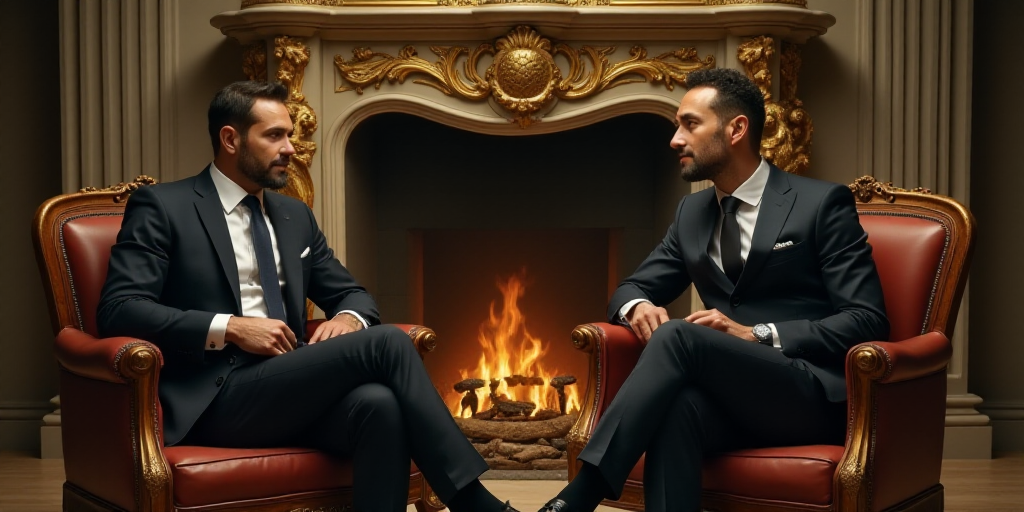Background and Relevance of Key Figures
On a unique day at the White House, U.S. President Donald Trump announced his efforts to arrange a summit between Ukrainian President Volodymyr Zelensky and Russian President Vladimir Putin. The meeting comes after a series of high-level encounters in Washington, involving key European leaders such as Friedrich Merz from Germany, French President Emmanuel Macron, and Italian politician Giorgia Meloni.
Trump, aged 79, has been instrumental in facilitating dialogue between the two nations amidst their ongoing conflict. His involvement is significant due to his previous influence on U.S.-Ukraine relations and his current role as a mediator.
Summit Preparations and Key Points
Trump confirmed that he had spoken with Putin over the phone following a “very good” meeting with Zelensky and European leaders. He stated that he had initiated preparations for a meeting between Putin and Zelensky, though the location remains undecided. Trump also mentioned plans for a trilateral meeting involving both presidents.
German Chancellor Friedrich Merz later confirmed from the White House that Putin had agreed to meet with Zelensky within the next two weeks. If successful, this would be the first meeting between the two leaders since Russia’s invasion of Ukraine nearly three and a half years ago.
Vice President JD Vance, Secretary of State Marco Rubio, and Special Envoy Steve Witkoff will oversee the preparations for this crucial meeting.
Security Guarantees for Ukraine
The White House hosted an extraordinary gathering involving Trump, Zelensky, and leaders from the UK, France, Germany, Italy, Finland, the European Commission, and NATO.
Zelensky first had a private meeting with Trump in the Oval Office, which he described as the “best” encounter with the U.S. President so far. Trump praised Zelensky’s attire, contrasting his previous criticisms of the Ukrainian leader’s informal style. Trump warned that within a couple of weeks, they would know whether peace could be achieved or if the conflict would persist.
Prior to the Washington meeting, Trump urged Kyiv to relinquish Crimea and abandon its NATO membership aspirations, meeting two of Russia’s primary demands. He also suggested considering “possible territorial exchanges” as a negotiation tactic.
Reports suggest Putin is pushing for Ukraine to cede the eastern Donbas region, still largely under Kyiv’s control, in exchange for freezing the offensive in other areas. Zelensky rejected this outright, receiving support from Merz.
Trump addressed security guarantees for Ukraine in a potential peace agreement, stating that Putin had agreed to them. Several European countries will provide these guarantees while the U.S. acts as a coordinator, according to Trump.
NATO Secretary-General Mark Rutte emphasized that security guarantees were a central topic during the White House meeting.
Financial Times reported that Ukraine committed to purchasing $100 billion worth of U.S. weapons, funded by Europe, in exchange for security guarantees from the U.S.
Macron stressed that one of these security guarantees should be a “robust” Ukrainian military capable of deterring future invasions.
Zelensky announced that allies would formalize these guarantees within ten days.
European leaders emphasized the need for an immediate ceasefire. Rutte called for seizing this opportunity to achieve lasting peace, while Macron proposed a four-party meeting with European participation.
Merz deemed it “unthinkable” to hold the upcoming meeting without a ceasefire, stating that they are working on it and exerting pressure on Russia.
Intensifying Sanctions Against Russia
Macron urged for increased sanctions against Russia if Putin fails to progress towards peace with Ukraine.
“President Trump believes we can reach an agreement, and he believes President Putin wants a peace deal too,” Trump told reporters. “But if this process hits a dead end, we are also ready to say that we need to increase sanctions,” he added.
Finnish President Alexander Stubb expressed skepticism about Putin’s reliability.
“Putin is rarely someone you can trust. We’ll have to see if he has the courage to attend a trilateral meeting or if he tries to buy more time again,” Stubb said after leaving the White House.
Key Questions and Answers
- Who is involved in the summit? The summit involves U.S. President Donald Trump, Ukrainian President Volodymyr Zelensky, and Russian President Vladimir Putin. European leaders such as Friedrich Merz, Emmanuel Macron, and Giorgia Meloni are also participating.
- What are the main topics of discussion? The primary topics include security guarantees for Ukraine, territorial concessions, and achieving a lasting ceasefire in the conflict.
- What role is Donald Trump playing? Trump is acting as a mediator, facilitating dialogue between Zelensky and Putin, and coordinating security guarantees from European allies.
- What are the security guarantees for Ukraine? European countries will provide security guarantees to Ukraine, while the U.S. will coordinate these efforts. One proposed guarantee is a robust Ukrainian military capable of deterring future invasions.
- What are the potential sanctions against Russia? If Putin fails to make progress towards peace with Ukraine, there are plans to intensify sanctions against Russia. This decision would be supported by the U.S. and European allies.






